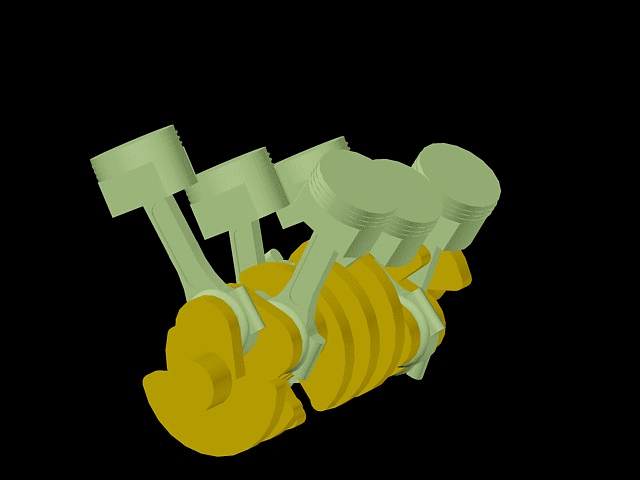|
|
Six Cylinder V-engine
| Firing orders |
| VR-engine | 1 5 3 6 2 4
(Crankshaft as in an in-line engine) |
| V-engine | 1 6 2 4 3 5 |
| The VR-6 is not a true V-engine. |
Basically, this engine exists in two construction types. The in-line-V-engine corresponds to the five cylinder-VR-engine.The other construction form
concerns a true V-engine.
Here one distinguishes between the classic example with two connecting rods on one crankpin and particularly, the new form of six-cylinder, in which each cylinder has it's own crankpin (see figure 5). The higher construction complexity is
justified by an absolutely even distribution of the combustion strokes which allows a more cultured running.
| Shorter thus more compact than the straight-six. |
This type of engine has two cylinder banks with separate cylinder heads. It is considerably shorter than the in-
line engine and the VR-engine. One speaks of a higher performance density. This makes it equally
attreactive for straight- and for transverse installation.
| It cannot compare with the silky-smooth running of the BMW six-cylinder. |
One has to accept the certain roughness that it produces. As far as the mass-forces 1. and 2. are concerned, it is by far, not as well balanced as it's boxer- and in-line counterparts. Therefore, offset-compensation
shafts are frequently installed.
| Suitable for straight- and transverse mounting |
However, it can score points through it's shorter construction length and it's favourable power to weight ratio. The short crankshaft is also less burdened, because the longer the shaft is, the higher the rotary oscillations
are. In addition, through less main bearings, the power dissipation is lower.
| V-6 alone or in modular construction system |
It's not surprising, that apart from the four cylinder in-line engine, this engine is the most frequently found. Only BMW, with their in-line six, remains steadfast. Otherwise, there are hardly any larger companys, who don't
have it in their program, sometimes it can even be upgraded to a V-eight-cylinder.
| What does a classic V-engine look like? |
This leads to the difficult question of the angle between the two cylinder banks. Basically, the ignition angle arises, when one divides 720° by 6, giving 120°. With such a bank angle, a pretty simple crankshaft with three
crankpins, each carrying two connecting rods would be possible and would correspond to the classic V-engine. However, with this amount of width, it would become as unwieldy as it's boxer counterpart.
| Connecting rod offset is the ignition angle minus the bank angle |
Somewhat removed from the classic engine, is the V-6 with 90°, where the two connecting rods on the crankpin can be offset by the necessary 30°. Apart from this, one can quite easily, using the modular construction
system, add two further cylinders. Fitting in with this, there has already been a V-10 in the truck area. However, should the engine, as in most cases, have a 60° angle, then additional crankpins are necessary.
| With one crank per cylinder almost any bank angle is possible. |
With bank angles of 120- and 90 degrees, the offset of the two cylinder banks is only the width of one connecting rod. With 60° between the banks, two further connecting rod widths are added. Then however, an angle
differing from 60°, e.g., 54° (Opel) is possible. In this case, we have arrived at the modern V-6, of course, four camshafts for the four valves per cylinder must still be added.
| Valve drive distinctly more complex than in a straight engine. |
Yes, the complexity of the valve-drive in this engine is much higher than in an in-line engine. Just imagine the possible bonus of an adjustable stroke, e.g., in a BMW engine. The number of valves is not a problem,
indeed, the complexity increases with the number of camshafts.
| Specific characteristics of the gas supply |
Quite a lot fits into the V. Where earlier there were injection pumps, e.g., a shift induction pipe is now found.
There can also be an intake-air compression device. After all, the air enters the cylinder head at a slant from above, which is generally seen as an advantage for the performance development of the engine.
| Specific characteristics of the gas removal |
Therefore the exhaust pipes must be laid around the outside, only coming together afterwards, possibly with twice the amount of decontamination elements. Indeed, the performance fan does have the possible
advantage of two, separate tailpipes, where, e.g., in an in-line six, they must be artificially laid next to each other. 09/08

|
|